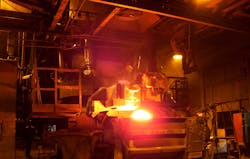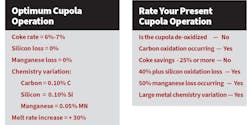Previous articles in this series have pointed out and hopefully will lead to the understanding that iron oxide supplies the harmful free-oxygen atoms so harmful to iron-melting processes. Iron oxide is produced during the cupola melting cycle. It is not contained in the metallic charge ingredients, and it is produced as the melting process progresses.
The cupola melt cycle begins with pristine materials, primarily coke and clean metallic scrap. Blast air entering the cupola through tuyeres creates a very hot — 5,000°F — zone immediately in front of the tuyeres. Molten metal droplets are created, which descend through this high-temperature zone.
The oxygen-rich blast air creates the high-temperature zone, with the tuyere areas being the only places within cupolas where oxygen exists. Away from the tuyeres, blast-air oxygen has been converted – reacted – and consumed by the coke-combustion process to form “oxides” – carbon monoxide or carbon dioxide.
It is in the oxygen-rich areas that combustion heat is developed, but it is also there that iron oxide forms. As previously discussed, once iron forms free-oxygen atoms are continuously supplied to the molten iron. Because the tuyere region is the area of extreme heat within the cupola, carbon present within the molten iron oxidizes rapidly.
The cupola melt process is dynamic: melting and superheating occurs … carbon oxidation occurs … carbon is lost to the oxidation … the descending droplets contact the superheated and graphitized coke … carbon is picked up from the coke … droplets continue to descend in the cupola, arriving at the retained slag layer … and iron oxide in the retained slag layer causes silicon oxidation losses due to the lower temperature at that point in the melting cycle.
In the tuyere area where iron oxide is formed, the 5,000°F temperature causes a portion of the freshly formed iron oxide to vaporize along with a portion of molten iron and coke ash (SiO2). This vaporized gas spreads throughout the upper cupola. Upon cooling, the gas condenses into a liquid, contaminating the entire upper cupola with iron oxide.
This iron oxide provides the same free-oxygen atoms as those provided in the tuyere area, but the oxidation reactions favored by the Laws of Thermodynamics in the lower temperature region is the oxidation of silicon from the molten iron.
Carbon is oxidized in the tuyere area and silicon is oxidized in the lower melt zone.
When DeOX is injected through the cupola tuyeres, iron oxide present in the tuyere area is instantly chemically reduced to the inert by-products. This eliminates the supply of free-oxygen atoms to the molten iron, which immediately stops carbon-oxidation losses and eventually stops iron-oxide contamination throughout the cupola, which stops silicon-oxidation losses.
Carbon oxidation is instantly stopped with DeOX tuyere injection. Carbon levels increase quickly and melt personnel must pre-plan the DeOX tuyere injection to prevent out-of-spec iron chemistries.
Carbon levels have risen from 0.60% C to over 1.00% C with DeOX injection. The increase encountered depends on the carbon losses currently occurring.
Most cupola charges include silicon-carbide briquettes, which add both carbon and silicon to the iron. DeOX reduces the amount of SiC briquettes needed and can eliminate them altogether in some cases, all based on the specific cupola operation and cupola charge employed.
The key to DeOX tuyere injection is to compensate the cupola charge to prevent elevated carbon and silicon levels once oxidation losses subside.Carbon increases occurring with DeOX injection can be partially offset by silicon-carbide briquette reductions. Coke-rate reductions are always needed to balance carbon levels to the level required. Those coke-rate reductions provide significant savings.
The DeOX injection rate, which neutralizes typical iron-oxide contamination in cupola melting is 0.4% DeOX, based on cupola charge weight. It is possible to begin DeOX injection at lower injection rates to prevent major changes in carbon levels, but pre-planning cupola-charge changes are easily employed too.
Much can be anticipated if the tap-out chemistry is known, which facilitates cupola charge changes ahead of the DeOX injection. Every cupola furnace in current operation has potential for cost savings. A confidential, no-cost analysis of current melting operations is available, after on-site review.
Ron Beyerstedt is the president of Mastermelt LLC. Contact him at [email protected]
This is the fifth in a series of reports examining cupola design, cupola melting practice, and cupola technology solutions. Also see:
Maximizing Cupola Performance, FM&T March 2021.
Controlling Conditions for Cupola Melting, FM&T April 2021.
Cupola System Design Optimizes Melting Operations, FM&T May 2021
Optimizing Cupola System Design, FM&T June 2021
About the Author
Ron Beyerstedt
Ron Beyerstedt is the president of Mastermelt LLC. Contact him at [email protected]

